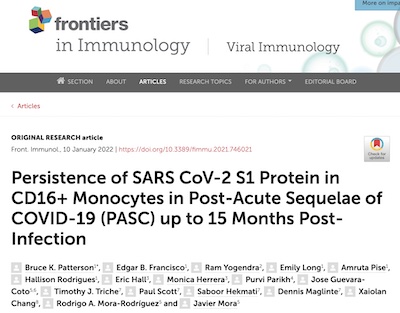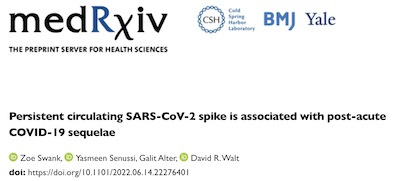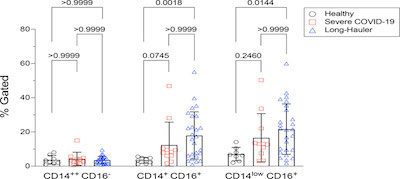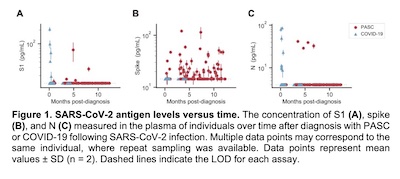On Biomarkers for Long COVID-19
Tagged:COVID
/
JournalClub
/
MathInTheNews
/
PharmaAndBiotech
/
Statistics
Some crazy people are suspicious that Long COVID-19 is not a real thing. So we’re gratified here at Chez Weekend to find papers documenting some biomarkers for it that look pretty good!
Long COVID-19 skeptics
There’s a certain kind of cruel conservative viewpoint encouraging suspicion that the suffering of “those people” is not real, or at least not as serious as claimed. This particularly applies to conditions affecting non-whites (e.g., sickle cell anemia) or women (e.g., chronic fatigue syndrome). Since they view COVID-19 as a preoccupation of the liberal, they are also suspicious that Long COVID-19 (now called “post-acute sequelae of COVID-19”, or PASC) is just “malingering.”

 Well, no more: 2 recent papers (the 2nd one is a
preprint) [1] [2]
have found some interesting biomarkers in patients with PASC that are causally related to
the disease. In short, viral protein fragments are circulating in their blood and
contained in monocytes, indicating a hidden reservoir of virus somewhere.
Well, no more: 2 recent papers (the 2nd one is a
preprint) [1] [2]
have found some interesting biomarkers in patients with PASC that are causally related to
the disease. In short, viral protein fragments are circulating in their blood and
contained in monocytes, indicating a hidden reservoir of virus somewhere.
In short, they’re very provably still sick; this is a real condition we need to take very seriously, since it seems to affect about 30% of COVID-19 patients according to the Patterson paper!
The Patterson paper was a study of 144 patients = 29 normal + 26 mild/moderate COVID-19 +
24 severe COVID-19 and 64 with Long COVID-19/PASC. By comparing these groups, they established:

- Some populations of monocytes (intermediate CD14+/CD16+ and non-classical CD14lo/CD16+)
were elevated in PASC up to 15 months after the initial infection compared to healthy
controls (nonparamatrically, p<0.002 and p<0.01 by
Kruskal-Wallis test;
no idea why they did it nonparametrically instead of the parametric equivalent ANOVA).
That’s what shown in Fig 1 of the paper, reproduced here:
- The black circles are the normals, the red squares are the severe COVID-19 patients, and the blue triangles are the Long COVID-19 patients. (No idea what happened to the 26 mild/moderate patients?)
- We see that in both CD14+/CD16+ and CD14lo/CD16+ monocytes, there is an elevation with respect to normals.
- While it looks like there’s a trend of elevation between severe and Long COVID-19, it’s not statistically significant.
- Note that the classical monocytes, in the first column, express ACE2 while the other types of monocytes pretty much do not. So SARS-CoV2 can attack the classical monocytes harder, but the others can survive for a long time potentially preserving some viral proteins from the infection.
- And that’s the second finding: the non-classical monocytes (CD14lo/CD16+) had measurable
amounts of the S1 subunit of the SARS-CoV2 spike protein, confirmed by mass
spectrometry.
- This might mean there are hidden virus caches in those patients, persistently re-infecting them at a low level.
- However, viral mRNA was not found, indicating that maybe their immune system was holding on to the viral proteins and keeping up inflammation long past the infection.
- Either way, their reported symptoms look quite real, at the molecular level.
Whatever’s going on, the Long COVID-19 patients had perturbed immune systems and measurable amounts of the receptor binding domain (RBD) of the viral spike protein running around in their bodies.
The Swank paper looked in different places, but found a strikingly similar result. They looked in blood plasma of 63 COVID-19 and PASC patients. They found persistent circulating levels of SARS-CoV2 spike protein in the blood plasma for up to 12 months post-infection in the majority of PASC patients. They favor the hypothesis of a hidden reservoir of virus in PASC patients.
 That’s what’s shown in their Figure 1, reproduced here:
That’s what’s shown in their Figure 1, reproduced here:
- (A) is just the S1 subunit of the spike protein, (B) is the full spike protein, and (C) is the nucleocapsid protein (from inside the viral envelope).
- The blue dots are COVID-19 patients who did not exhibit PASC, while the red dots are PASC patients.
- The full spike protein keeps popping up, well above the assay limit of detection, in the PASC patients.
- Note that they do not see circulating S1 subunit or nucleocapsid in the plasma, but do see the full spike protein. This is perhaps a better reason to support the hypothesis of a viral reservoir, since it’s got a full spike protein and not just the S1 subunit?
So there are a few differences between the papers:
- Patterson found differences in monocyte populations, which Swank did not measure.
- Swank found viral proteins circulating in blood plasma, which Patterson did not measure.
- Patterson found just the S1 subunit (the RBD of the spike protein) inside monocytes, whereas Swank found the full spike circulating in blood plasma.
The details are not fully consistent at this point, but the general point is clear: long COVID-19 is a real thing, and the people who have it are still sick (viral proteins or subdomains of them are still around, and monocyte populations in their immune systems are still distinct from healthy patients).
The Weekend Conclusion
Long COVID-19 is real. The biomarkers look statistically significant and robust, and are related to the disease mechanisms (the viral proteins themselves). It seldom gets any better than that.
Long COVID-19 happens up to 30% of the time, so it’s also frequent enough that it’s a problem. We need to find serious treatment for it!
Notes & References
1: BK Patterson, et al., “Persistence of SARS CoV-2 S1 Protein in CD16+ Monocytes in Post-Acute Sequelae of COVID-19 (PASC) up to 15 Months Post-Infection”, Front Immunol, 12:746021, 2022-Jan-10. DOI: 10.3389/fimmu.2021.746021. ↩
2: Z Swank, “Persistent circulating SARS-CoV-2 spike is associated with post-acute COVID-19 sequelae”, medRχiv, 2022-Jun-16. DOI: 10.1101/2022.06.14.22276401. ↩

Gestae Commentaria
Comments for this post are closed pending repair of the comment system, but the Email/Twitter/Mastodon icons at page-top always work.